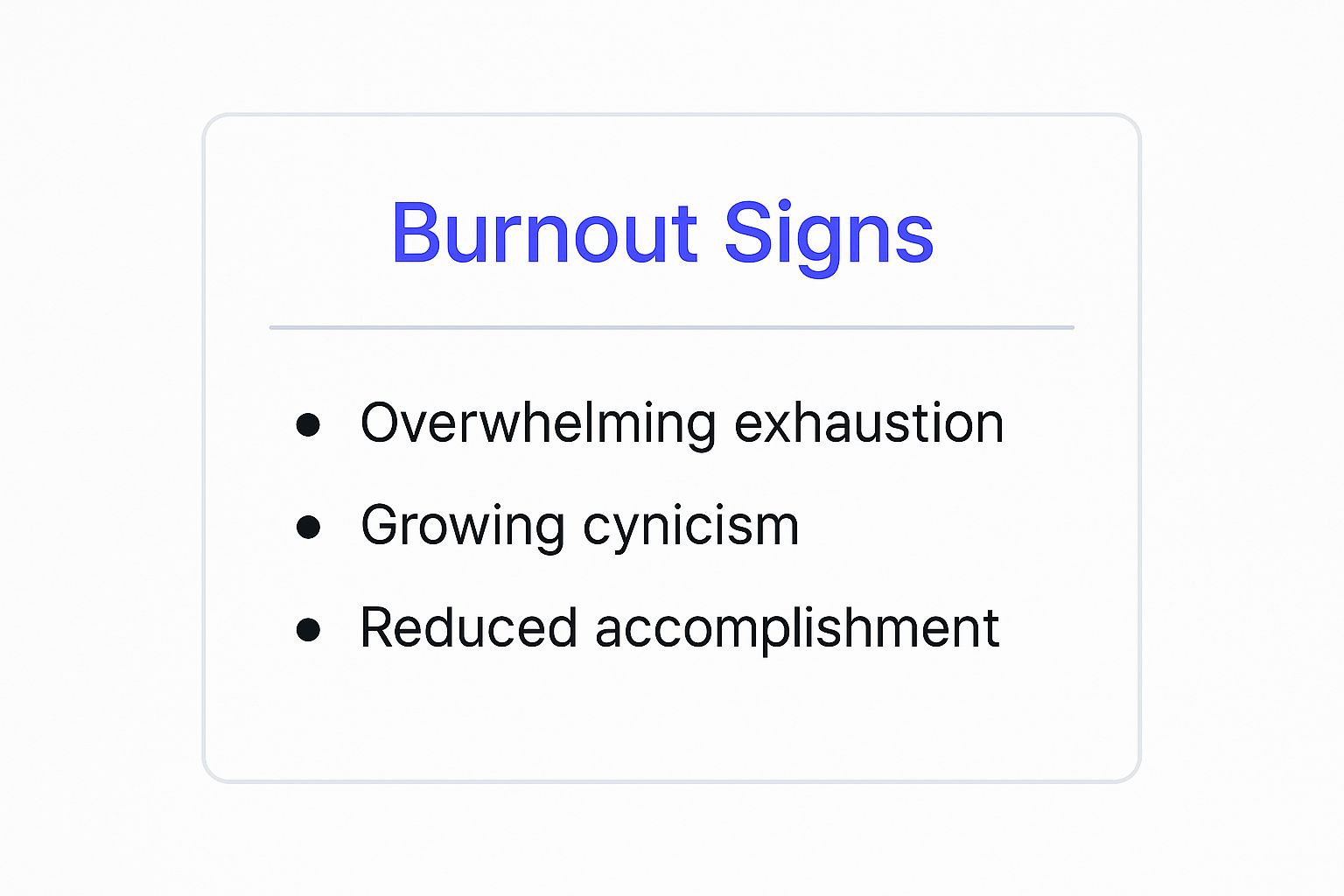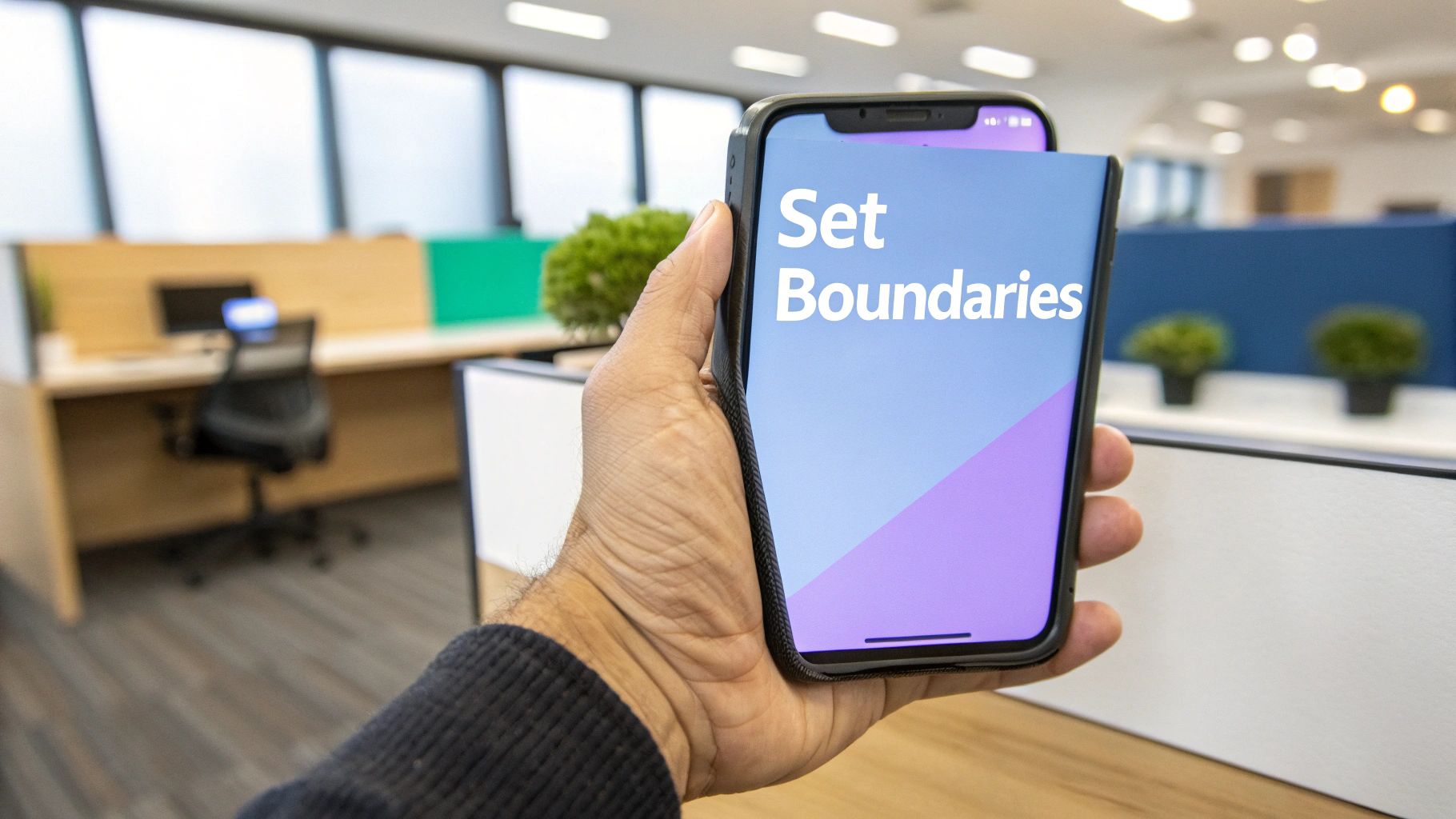How to Avoid Burnout at Work and Reclaim Your Energy
Learn how to avoid burnout at work with practical, real-world strategies for managing stress, setting boundaries, and building sustainable work habits.
Preventing burnout isn't just about managing your time better; it’s about managing your energy. It means setting real boundaries, taking breaks that actually recharge you, and learning to spot the warning signs before they spiral out of control.
This isn't about slacking off. It's about figuring out how to work in a way that’s sustainable for the long haul.
Understanding the Real Signs of Workplace Burnout
Burnout is a tricky thing. It’s far more than just feeling tired after a long week. We're talking about a state of chronic physical and emotional exhaustion that comes from being under too much stress for too long.
It’s easy to blame yourself, but burnout is often a reaction to a work environment that asks too much and gives too little back. This has become a massive issue, with some studies showing that nearly half of American workers feel stressed out every single day. To get ahead of it, you first have to know what you’re looking for.
These three core elements—exhaustion, cynicism, and a feeling of reduced accomplishment—are the classic trifecta of burnout.

Once these three get a foothold, they create a vicious cycle. They feed off each other, draining your motivation, your passion, and your energy bit by bit.
The Slow Creep of Burnout
Burnout rarely happens overnight. It's a gradual slide.
Take Alex, for example—a talented graphic designer who genuinely loved coming up with new ideas. After six months in a high-pressure job with impossible deadlines and zero positive feedback, that passion started to die out.
First came the exhaustion. We're not just talking about being tired; it was a bone-deep weariness that a full night's sleep couldn't fix. This kind of physical drain is often the first red flag. It’s also common to feel it in your eyes after staring at a screen all day, so it’s worth learning some tips on how to avoid eye strain from your computer.
Then, the cynicism started to creep in. Alex began to feel disconnected, and new projects felt like a burden instead of an exciting challenge.
Finally, a sense of ineffectiveness settled in. Even though Alex was putting in more hours than ever, the work just didn't feel good enough. This is a classic burnout progression, and it shows how it can quietly dismantle your professional self-esteem.
Burnout isn't a sign of weakness; it's a sign you've been strong for too long. Recognizing the symptoms early is the first, most powerful step toward reclaiming your well-being.
To help you get a clearer picture, I've put together a quick reference table. It contrasts those subtle, early warnings with the more glaring signs that burnout has taken a serious hold.
Burnout Symptoms At a Glance: Early vs. Advanced Stages
| Symptom Area | Early Warning Signs | Advanced Stage Indicators |
|---|---|---|
| Physical | Persistent tiredness, headaches, trouble sleeping | Chronic fatigue, frequent illness, changes in appetite |
| Emotional | Feeling irritable, occasional anxiety, loss of enjoyment | Pervasive cynicism, feeling detached, sense of hopelessness |
| Behavioral | Procrastinating more, withdrawing from colleagues | Isolating yourself, increased absenteeism, poor performance |
Think of this table as a quick self-check. Seeing yourself in the "Early Warning Signs" column is a signal to act now before things get worse.
Identifying Your Personal Burnout Triggers

If you want to get a real handle on burnout, you have to move past generic complaints like "my workload is too heavy." That's not an actionable insight; it's just a feeling. The real breakthrough comes when you can pinpoint the specific situations, tasks, and dynamics that consistently leave you feeling drained.
Think of it like being a detective in your own work life. Your mission is to gather clues about what pushes you toward exhaustion and, just as importantly, what pulls you back. This self-audit is the bedrock of any real strategy to keep burnout at bay.
Start Tracking Your Energy, Not Just Your Tasks
For one full week, keep a simple journal or a note on your phone. The goal isn't to create another to-do list, but to track your emotional and energetic state throughout the workday. This isn’t about judging your performance; it’s purely about collecting honest data.
At the end of each day, take five minutes to reflect on a few direct questions. Don't censor yourself or overthink it—just jot down whatever comes to mind first.
- When did I feel most engaged or energized today? Was it during that brainstorming call with the team? Maybe it was the two hours you had for deep, focused work on that one big project.
- What moments left me feeling completely drained? Was it the back-to-back-to-back meetings? The constant pinging of notifications? Or perhaps the mental load of trying to juggle three "urgent" projects at once?
- What did I put off doing the most? We often procrastinate on the things that overwhelm or frustrate us, which makes procrastination a great clue for spotting a burnout trigger.
After just a few days, you'll start seeing patterns you never noticed before. You might realize that you love the creative part of your job but spend 60% of your time on administrative tasks that feel like a slog. That kind of mismatch is a classic recipe for burnout.
Key Takeaway: Burnout isn’t always about working too hard. More often, it’s about spending your energy on work that feels draining, unfulfilling, or completely disconnected from your strengths.
Look at the Environment Around You
Once you have a handle on your internal responses, it's time to look outward. Your work environment plays a huge part in your daily well-being, and spotting the stressors here can show you what you can (and can't) control.
Consider how these common environmental factors might be affecting you:
- A Lack of Control: Do you have the autonomy to make decisions about your own work, or is every little thing micromanaged? Feeling powerless is a fast track to stress.
- Vague Job Expectations: Is it crystal clear what you're responsible for and what "success" looks like? Constant uncertainty is mentally exhausting.
- Poor Communication: Does feedback only come when something is wrong? Working in a vacuum without constructive guidance or positive reinforcement can make you feel completely disconnected and unappreciated.
Getting a clear picture of these triggers is the first step toward actually doing something about them. If you're not sure how stressed you really are, an objective tool can provide a useful baseline. Our free stress level calculator can give you some quick clarity.
By mapping out this personal burnout blueprint, you're no longer just reacting to stress—you're getting ahead of it and building a more sustainable way to work.
Building Daily Habits to Combat Stress

Knowing your burnout triggers is one thing, but actively fighting them is a whole different ball game. The most effective way I've seen people manage workplace stress is by preventing it from piling up in the first place. This isn't about making massive, life-altering changes overnight. It’s about weaving small, sustainable habits into your daily routine that act as little pressure-release valves.
Instead of waiting until you feel completely steamrolled, you can build a defense system made of tiny, intentional actions. These habits create small pockets of relief and recovery, making you far more resilient over the long haul.
Introduce Micro-Breaks and Mindful Moments
The very idea of taking a break can feel like a luxury, especially on a day when your calendar is packed wall-to-wall. But both research and real-world experience show that short, frequent breaks are far better for keeping your focus and energy up than one long lunch break. The trick is to make them count.
This is where the micro-break comes in. It’s not about mindlessly scrolling through social media, which often just adds to the mental clutter. It’s about genuinely disconnecting for just a few minutes.
A great way to start is with what I call the '5-Minute Reset.' After a tough meeting or once you've finished a demanding task, set a timer for five minutes and get away from your screen. You could do a few simple stretches, walk to the kitchen for a glass of water, or just stare out the window for a bit. Tossing in some mindfulness techniques, like simple breathing exercises for anxiety, can be especially powerful for calming your nervous system in these short windows.
Your brain isn’t a computer; it can’t run at maximum capacity for eight hours straight. Think of micro-breaks as hitting the refresh button on your focus and creativity, giving you a much-needed mental reset.
This tiny habit interrupts the cycle of non-stop stress before it can build into something bigger. There are so many surprising benefits of work breaks for productivity that go way beyond just feeling rested.
Create a Digital Sunset
In our always-on work culture, the line between work and personal life has become incredibly fuzzy. Firing off one last email at 9 PM can easily suck you back in for another hour, robbing you of essential downtime. This is precisely why creating a "Digital Sunset" is so vital for preventing burnout.
The habit is straightforward: designate a hard stop time for all work-related devices at least an hour before you plan to sleep. That means no more work emails on your phone, no checking Slack messages, and definitely no reviewing documents from bed. This buffer period gives your brain a chance to switch out of work mode and actually wind down, which dramatically improves your sleep quality and cuts down on next-day fatigue.
A Microsoft survey really drove this point home, finding that a staggering 50% of workers reported feeling burned out. The data also showed that employees clocking over 40 hours a week were far more likely to hit a wall than those with more reasonable schedules, proving just how crucial boundaries are.
Reclaim Your Commute or Transitions
If you commute to an office, that travel time can be either another source of stress or a powerful tool for decompression. Instead of mentally running through your to-do list or replaying a frustrating meeting, use your commute to create a mental boundary between work and home. Put on a podcast, an audiobook, or music that genuinely helps you relax.
For those of us working from home, this transition is even more critical. Since there's no physical separation, you have to create a ritual. It could be as simple as a quick walk around the block, a 10-minute tidy-up of your workspace, or changing out of your "work clothes." This small act signals to your brain that the workday is officially over, helping you be more present and engaged in your personal life.
Setting Boundaries That Actually Stick

We've all heard the advice: "Just say no." If only it were that simple.
In reality, the fear of looking like you're not a team player or that you're uncommitted can be paralyzing. It’s what pushes us to say "yes" to one more thing, even when our plate is already overflowing. But learning how to avoid burnout at work isn't about shutting people down; it's about developing smart, professional strategies to protect your time and energy.
Think of it less like building a wall and more like drawing a line in the sand. A clear boundary is a sign of self-respect. It shows you’re committed to delivering your best work on your most important projects, rather than spreading yourself too thin across everything.
Master the Art of the Professional Pushback
Saying "no" rarely has to be a blunt, one-word answer. The real skill is in communicating your current workload and priorities while offering a different path forward. This approach shows you’re still engaged and helpful, just not at the expense of your core responsibilities.
Keep a few of these phrases in your back pocket and adapt them to your own voice:
- When you’re at full capacity: "I appreciate you thinking of me for this. Right now, I'm completely focused on getting Project X over the finish line for its deadline, so I can't give this the attention it deserves."
- When the request isn’t for you: "That sounds like a key initiative. Based on what you're saying, Sarah over in marketing probably has the exact expertise you need. Want me to make an introduction?"
- When you need to delay: "This sounds interesting, and I'd like to help. I'm booked solid for the next two weeks, but could we circle back on this at the beginning of next month?"
Framing your response this way turns a simple yes/no question into a more productive conversation about timing, resources, and priorities.
A boundary isn't a rejection of other people; it's a protection of your own focus and well-being. It communicates that you value your own work and time, which encourages others to do the same.
Protect Your Digital Space
In our always-on work culture, digital boundaries are just as crucial as physical ones. With remote work blurring the lines between the office and the living room, setting these boundaries has become non-negotiable for staying sane.
The numbers don't lie. A Deloitte survey found that a staggering 77% of employees have felt burnout at their current job. Even more telling, 65% of remote workers say they work longer hours than they did in the office. This is almost always fueled by a lack of clear expectations and the feeling that you can never truly log off. You can dig deeper into the data in this report on remote work burnout statistics.
Here are two digital habits you can start today:
- Define Your Availability: Get comfortable using the status features in tools like Slack or Microsoft Teams. Set your status to "away" and, more importantly, turn off notifications outside of your working hours. It’s a simple signal to your team that you’re done for the day.
- Automate Your After-Hours Communication: If late-night emails are the norm, set up an auto-responder. A quick message like, "Thanks for your email! I'm offline for the evening but will get back to you during business hours tomorrow," manages expectations for you.
These small, consistent actions help you reclaim your personal time. That’s the space you need to actually recharge, so you can show up the next day feeling refreshed instead of already behind.
Redefining Your Relationship with Work
https://www.youtube.com/embed/LLCsmLjUZNA
Daily habits and setting firm boundaries are your best frontline defense against burnout, but lasting prevention demands something more. It's about fundamentally reframing how you see your job—shifting from a survival mindset to one of intentional career building.
This means finding ways to connect your daily grind with the things that actually energize you. And often, that journey starts with a simple, honest conversation. If your workload is the root cause of your stress, talking to your manager about it is the first real step toward a sustainable fix.
How to Talk to Your Manager About Your Workload
Bringing up your workload can feel daunting. I get it. The trick is to frame it as a collaborative problem-solving session, not a complaint. You're not saying you can't do the work; you're suggesting a better way to deliver high-quality results without hitting a wall.
Before you even think about putting a meeting on the calendar, do your homework. You need to walk in with specifics, a professional tone, and a few ideas up your sleeve.
- Gather Your Data: Start by tracking your time for a week. Seriously, write it down. See how many hours go into major projects versus administrative quicksand or those "quick" requests that pop up all day. This gives you concrete evidence.
- Show the Impact: Don't just say "I'm swamped." Connect your workload to business outcomes. Try something like, "I've noticed that with my current project load, I'm not getting the deep-focus time required for the Q4 strategy document, and I'm concerned about its quality."
- Propose Solutions: Come to the table with potential fixes. Could a recurring, low-impact task be delegated? Is it possible to push the deadline on a less critical project? This shows you're not just offloading problems—you're an engaged partner in finding a solution.
When you have the conversation, keep your cool and stay focused on your shared goal: contributing effectively. This kind of proactive communication is how you start to mold your role into something that truly works for you.
Key Insight: The goal isn't to do less work, but to do the right work. A constructive conversation with your manager can help realign your tasks with what creates the most value for both you and the company.
Find Your Support System
You don't have to power through workplace stress on your own. In fact, you shouldn't. Building a solid support network is one of the most powerful things you can do to stay grounded and keep things in perspective. This can look a few different ways.
Peer Support Networks: There's immense value in connecting with colleagues who just get it. They understand the unique pressures of your role or industry in a way others can't. Sharing those experiences can validate what you're feeling and make you feel a whole lot less isolated. It's more than just venting; it's about trading strategies and reminding each other you're in it together.
Mentorship: Finding a mentor can be a game-changer. A great mentor offers that crucial outside perspective, helping you see the forest for the trees when you're stuck in the weeds of daily frustrations. They can give you advice on everything from navigating office politics to developing new skills, guiding you toward a more fulfilling long-term path.
Ultimately, redefining your relationship with work isn't a one-and-done task. It's a continuous process of checking in with yourself. Every so often, ask: What parts of my job actually make me feel good? How can I do more of that? By consciously steering your daily efforts toward your core values, you can build a career that fuels you instead of drains you.
Got Questions About Burnout? We’ve Got Answers.
Even when you know the signs, figuring out how to deal with burnout can feel complicated. Let's clear up a few common questions that I hear all the time.
Stress vs. Burnout: What’s the Real Difference?
This is probably the most important distinction to make. People use the terms interchangeably, but they are worlds apart.
Think of stress as a feeling of being overwhelmed—too many deadlines, too many demands, too much pressure. It's that feeling of "if I could just get on top of this, I'd be okay." You're still engaged, just overextended. You're paddling frantically.
Burnout is different. It's not about having too much; it's about feeling like you have nothing left. It’s a profound sense of emptiness, emotional exhaustion, and just not caring anymore. With stress, you're drowning in responsibility. With burnout, you feel completely dried up.
The real giveaway? Hope. Someone who's stressed can usually still see a path forward. When you're truly burnt out, it feels like the lights have gone out for good.
Can I Really Beat Burnout Without Quitting My Job?
Yes, absolutely—if the conditions are right. It takes a conscious effort, but recovery is definitely possible if you can pinpoint what's causing your burnout and actually do something about it. This usually means getting serious about setting boundaries, having some tough but necessary conversations with your manager about your workload, and building non-negotiable habits that protect your energy.
But let's be realistic. If you're in a genuinely toxic environment where the core problems—like an impossible workload or a total lack of respect—are just part of the culture, it's an uphill battle. If the company won't budge on the very things that are burning you out, leaving might be the only healthy move.
How Much of This Is on My Employer?
While we all have to take ownership of our well-being, employers have a huge part to play. In fact, burnout is now widely seen as an organizational problem, not a personal failure.
Your company is responsible for things like:
- Managing Workload: Are workloads actually achievable for a human being?
- Setting Clear Expectations: Does everyone know what their job is and what success looks like?
- Building a Supportive Culture: Is it a place where people feel valued and psychologically safe?
Ultimately, preventing burnout is a two-way street. Your job is to speak up, set your limits, and take care of yourself. Your employer's job is to create an environment where you can actually do that.
Ready to build healthier work habits and stop burnout before it starts? DeskBreak is a simple browser extension that reminds you to take structured, guilt-free breaks. Reclaim your focus, protect your health, and make your workday more sustainable. Learn more and get started at https://www.deskbreak.app.